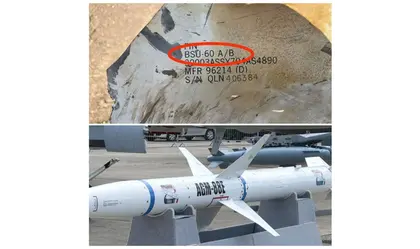A senior White House official on Monday confirmed recent reports Ukraine’s air force is now operating high tech HARM anti-radar missiles, a potentially game-changing weapon responsible for the claimed destruction of as many as 17 Russian army anti-aircraft systems over the last 72 hours.
Colin Kahl, the U.S. Undersecretary of Defense for Policy, told Washington reporters the US first sent Ukraine an unspecified number of AGM-88 High-speed Anti-Radiation Missiles (HARM) as part of a recent arms shipment. It was the first official acknowledgement the advanced US weapon was in use in combat in Ukraine.
- Check the most up-to-date Ukraine news reports from today.
- See the most contemporary Ukraine news reports for today.
JOIN US ON TELEGRAM
Follow our coverage of the war on the @Kyivpost_official.
“In recent military aid packages, we have included a number of anti-radar missiles that can be fired from Ukrainian aircraft and can affect Russian radars and other things,” Colin Kahl said during a press briefing on Monday.
Kahl said that the US and allies have also helped Ukraine get spare parts and other parts to get more Ukrainian MiG-29 fighter jets into the sky, but , he did not state the type of aircraft Ukrainian Armed Forces (UAF) used to launch the HARM.
Ukrainian military news platforms said either Romanian or Slovakian MiG-29 jets, both upgraded to NATO standards and now thought to be in the Ukrainian air force’s possession, were the missiles’ most likely launch platforms.
The HARM missile is a first-line advanced technology missile currently in use with US air and naval forces. A “smart” weapon, HARMS is designed to home in on anti-aircraft radars and to target the radars’ last location, even if the radar operators turn the anti-aircraft system off.

Ukrainian HIMARS Attack Blasts Russian Mobile HQ
Ukrainian social media followed by independent news platforms and official sources reported a spike in the damaged and destroyed Russian army air defense systems across the fighting front. Ukraine’s Joint Defense Command South claimed its units destroyed four RF S-300 systems on Sunday, and a Pantsyr-S1 system on Monday.
Data compiled by Ukraine’s Army General Staff (AGS) estimated the RF lost at least 17 air defense systems to all causes from Friday through Monday in fighting across Ukraine, but did not specify how the UAF destroyed the systems.
Russian social media and state-controlled news platforms on Sunday reported soldiers in the Mykolaiv-Zaporizhia sector recovered fragments of a US-made HARM missile from the debris of an S-300 anti-aircraft system recently destroyed by an air-launched weapon, with some reports showing images of a weapon serial number. Kahl’s Monday remarks effectively confirmed it was almost certainly a HARM missile.
In the early days of the war the Kremlin touted the S-300 anti-aircraft system (NATO designation SA-10 Grumble) as a key component of Russia’s purported massive technological superiority over Ukraine’s armed forces.
The UAF used long-range ground-launched rockets, conventional artillery and even high-risk behind-the-lines infantry raids past attempts to hit RF air defense systems like S-300. The distance at which the best Russian Federation air defense systems have been positioned behind Russian lines – typically 50-70 kilometers – has often placed Russia’s top-tier S-300 systems well out of the range of Ukrainian weapons.
Manufactured by Raytheon and Northrop Grumman, the HARM missile has a listed range of 185 km, making by a substantial margin far the longest-range weapon known to have been transferred by the US to Ukraine thus far in the war.
Depending on the type, a single HARM missile reportedly costs between $280,000 and $850,000. HARM missiles used by US and other air forces badly damaged ground-based air defenses in wars in Yugoslavia and Iraq, and were a key contributor to near-total allied air dominance in both conflicts.
You can also highlight the text and press Ctrl + Enter






